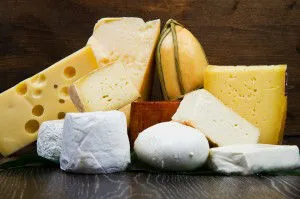Americans love their cheese. In fact, the average adult consumes over 30 pounds of the stuff each year. While it’s true that cheese may be a contributing factor to the current state of America’s poor health, this staple of many a meal, appetizer and snack doesn’t have to be a no-no.
Cheese is an excellent source of protein, and of calcium. In America, it is our second highest source of this vital bone-building mineral. Cheese can be the main player in many dishes (what would pizza be without the ooey gooey topping?), or it can simply enhance the flavor of many classics, like a sprinkling of parmesan on pasta.
So, if humans have been consuming this often-considered decadent ingredient for centuries, why are we still trying so hard to avoid it all costs? The main reason is because our cheese, like much of our food these days, just isn’t what it used to be.
The first processed cheese hit American markets in the 1920’s, when James Lewis Kraft discovered he could heat cheddar cheese to a melted consistency, add emulsifying salts and allow it to cool into a loaf. These “cheese loaves” were a hit thanks to their extended shelf life.
Over the years, the process evolved to include steam injections for added moisture content, different emulsifying agents and new additives to improve flavor. By the mid-1940’s, the individually wrapped slice hit supermarket shelves. Today, this convenient plastic-wrapped product accounts for 74 percent of total supermarket sales.
Thanks to improved processing techniques, our cheeses contain more fillers, preservatives and salt than ever before. And, thanks to the administration of hormones and antibiotics to our dairy cows along with their steady diet of GMO feeds, our milk is a far cry from the healthy beverage it used to be.
However, this doesn’t mean you can’t enjoy a few slices of cheese if you choose correctly. First, always select organic. This ensures that the cows supplying the milk have not been administered any harmful injections and have not been fed a GMO-based diet. Second, never select “low-fat” or “fat-free” varieties.
Aside from the fact that their taste and texture are a far cry from the real thing, they contain numerous additives and chemicals to make up for the lack of fat. If you’re looking for naturally lower-fat options, select softer cheeses like edam, mozzarella or feta. Their increased moisture means less fat per ounce, yet their flavor will provide satiety and satisfaction.
Harder cheeses generally contain more fat per ounce. Yet, due to the aging process of many hard cheeses, they are often easier for lactose-sensitive individuals to digest, as the lactobacillus bacteria breaks down much of the lactose during aging.
To avoid extra processing, don’t buy cheeses that are sold in forms different from their natural state. These would include individually wrapped products, pre-shredded, cubed, crumbled or sliced. Often, anti-caking agents and mold inhibitors have been added. Instead, buy the block and slice, shred or cube it yourself.

The best way to avoid processing when it comes to cheese is to make it yourself. Heating organic milk and rennet, then slowly removing and pressing the curds, is a simple method for first-time cheesemakers. A little patience and you could be slicing into your own unprocessed, organic cheese in no time.
-The Alternative Daily
Sources:
http://www.epa.gov/ttnchie1/ap42/ch09/final/c9s06-1.pdf
http://www.cnn.com/FOOD/resources/food.for.thought/dairy/compare.cheese.html
https://www.msu.edu/~mdr/vol14no2/ustunol.html
http://www.kitchendaily.com/read/healthy-types-cheese-low-fat-sodium
http://www.culturesforhealth.com/cheese-making-supply-list
